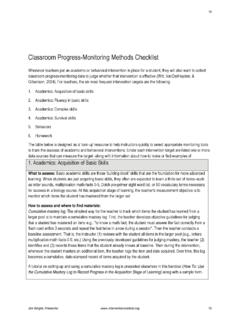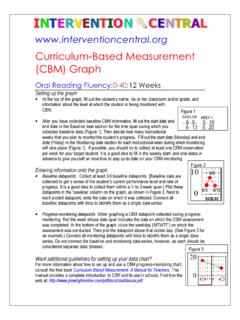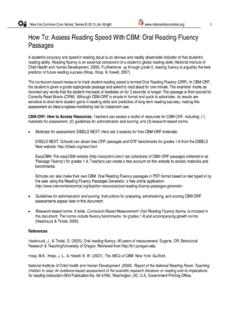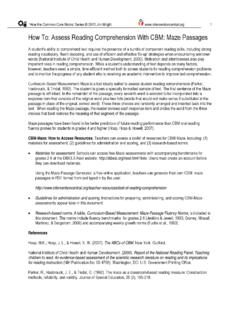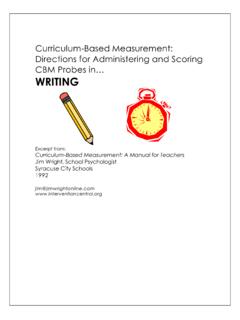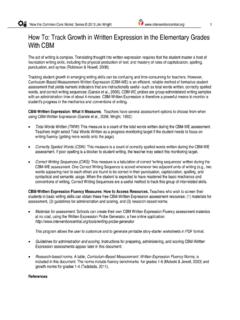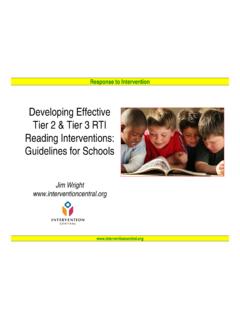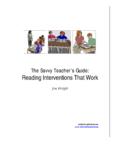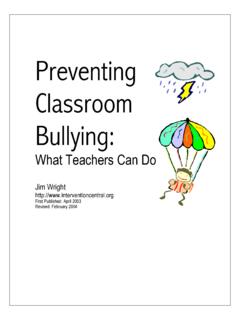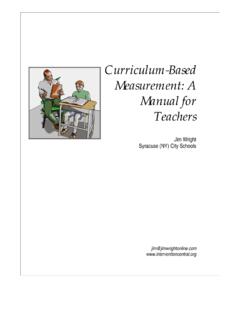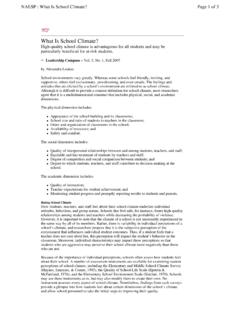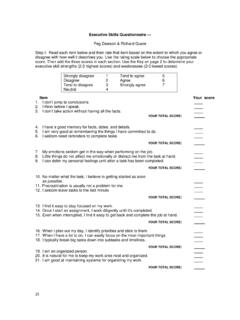Transcription of Classroom Behavior Report Card Resource Book
1 Jim Wright Resource book Report card Classroom Behavior About This The Classroom Behavior Report card Resource book contains ready-made forms that teachers can use to rate the behaviors of their students . It was updated in January 2003. About the Jim Wright is a school psychologist who lives and works in Syracuse, NY. He has worked for the past several years as a program developer and trainer for the School-Based Intervention Team (SBIT) Project for the Syracuse City School District. Jim has presented extensively to educators in the Syracuse area, across New York State, and in other parts of the country on effective school-based academic and behavioral interventions, Curriculum-Based Measurement, and violence prevention.
2 In November 2001, Jim was selected for the Leadership in School Psychology award by the New York State Association of School Psychologists. You can email Jim at Terms of This manual, The Classroom Behavior Report card Resource book , is protected under Copyright and is available to educators in public schools for non-commercial use. This document is available solely firm the Intervention Central web site ( ). Table of Contents Classroom Behavior Report card Resource book of ContentsIntroduction.
3 2 Section 1: General Classroom 2: Physical Aggression (Series I)..15 Section 3: Physical Aggression (Series II)..25 Section 4: Verbal Behaviors (Series I)..35 Section 5: Verbal Behaviors (Series II)..45 Section 6: Inattentive / Hyperactive 7: Socially Withdrawn 8: School Work-Related 9: Teacher-Selected Page 1 Classroom Behavior Report card Resource book Purpose of This Resource book .
4 The Classroom Behavior Report card Resource book contains pre-formatted teacher and student Behavior Report cards, along with customized graphs, for common types of behavioral concerns in the Classroom . It was designed to give teachers and other school professionals a convenient collection of forms for rating the behaviors of students in such areas of concern as physical aggression, inattention/hyperactivity, and verbal behaviors. How to Select a Teacher Behavior Report card . Behavior Report Cards are simple to use and can provide good information about student behaviors. When selecting a specific Behavior Report card , the instructor can get useful information each of the many pre-formatted cards in the Resource book by looking at the page header (see Figure 1).
5 Figure 1: Page Header InformationFrom left to right, the header indicates what class of behaviors the specific Report card is designed to measure, who is to complete the card (teacher or student), how many times the card can be used (once for Daily cards, across a full week for Weekly cards), and the level of the card (Primary vs. Intermediate/Secondary).Here are the steps to picking a Report teacher selects one or more students in the Classroom whose Behavior they would like to track using a Teacher Behavior Report card . teacher browses through the different behavioral 'sections' of the Resource book and selects a pre-formatted Teacher Behavior Report card that most closely matches the student behavioral concerns that they wish to measure.
6 The major behavioral sections and their behaviors appear below: Section 1: General Classroom Behaviors Section 2: Physical Aggression (Series I) Section 3: Physical Aggression (Series II) Section 4: Verbal Behaviors (Series I) Section 5: Verbal Behaviors (Series II) Section 6: Inattentive / Hyperactive Behaviors Section 7: Socially Withdrawn Behaviors Section 8: School Work-Related Behaviors Section 9: Teacher-Selected Behaviors (Blank forms with Behavior goals to be filled in by the teacher) teacher decides on the response format to use: Primary Level or Intermediate/Secondary Level. Primary Level cards have 'smiley faces' in addition to numbers in the response block, a format that teachers may prefer if they need to share their ratings with younger students .
7 The top item in Figure 2 is an example of the Primary Level response format. Intermediate/Secondary Level cards have a number response format, but lack the 'smiley faces'. The bottom item in Figure 2 shows a completed Intermediate/Secondary Level example. Introduction Page 2 Classroom Behavior Report card Resource book 2: Different Response FormatsPrimary Level Response FormatIntermediate/Secondary Level Response teacher decides whether to use Daily or Weekly Report Cards.
8 Daily cards can be used only once. Weekly cards have blanks for teachers to write down their ratings across a full school week (see Figure 3). Figure 3: Daily vs. Weekly Cards Daily Report card Weekly Report CardTeachers may want to use the Daily card format as a convenient behavioral record to be sent home with the student for parents to review. If the teacher plans to keep the Behavior Report card in the Classroom , the Weekly Report format is a convenient format recording the student's behaviors across multiple school days. teacher considers the option of having the student complete their own Behavior Report card (Optional.)
9 The Classroom Behavior Report card Resource book contains both teacher and student versions of all cards. While use of student cards is optional, teachers may choose to assign these cards to students to use in a self - monitoring program, in which the student rates their own behaviors each day. If teachers decide to use student Behavior Report cards, though, they should first identify and demonstrate for the student the behaviors that the Introduction Page 3 Classroom Behavior Report card Resource book is to monitor and show the student how to complete the Behavior Report card .
10 Since it is important that the student learn the teacher's behavioral expectations, the instructor should meet with the student daily, ask the student to rate their own behaviors, and then share with the student the teacher's ratings of those same behaviors. The teacher and student can use this time to discuss any discrepancies in rating between their two forms. (If Report card ratings points are to be applied toward a student reward program, the teacher might consider allowing points earned on a particular card item to count toward a reward only if the student's ratings fall within a point of the teacher's, to encourage the student to be accurate in their ratings.)
